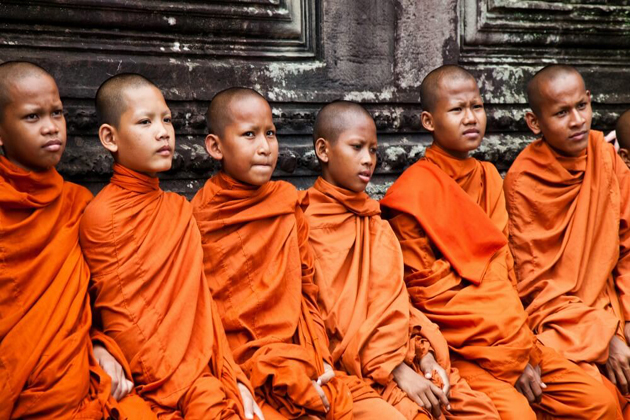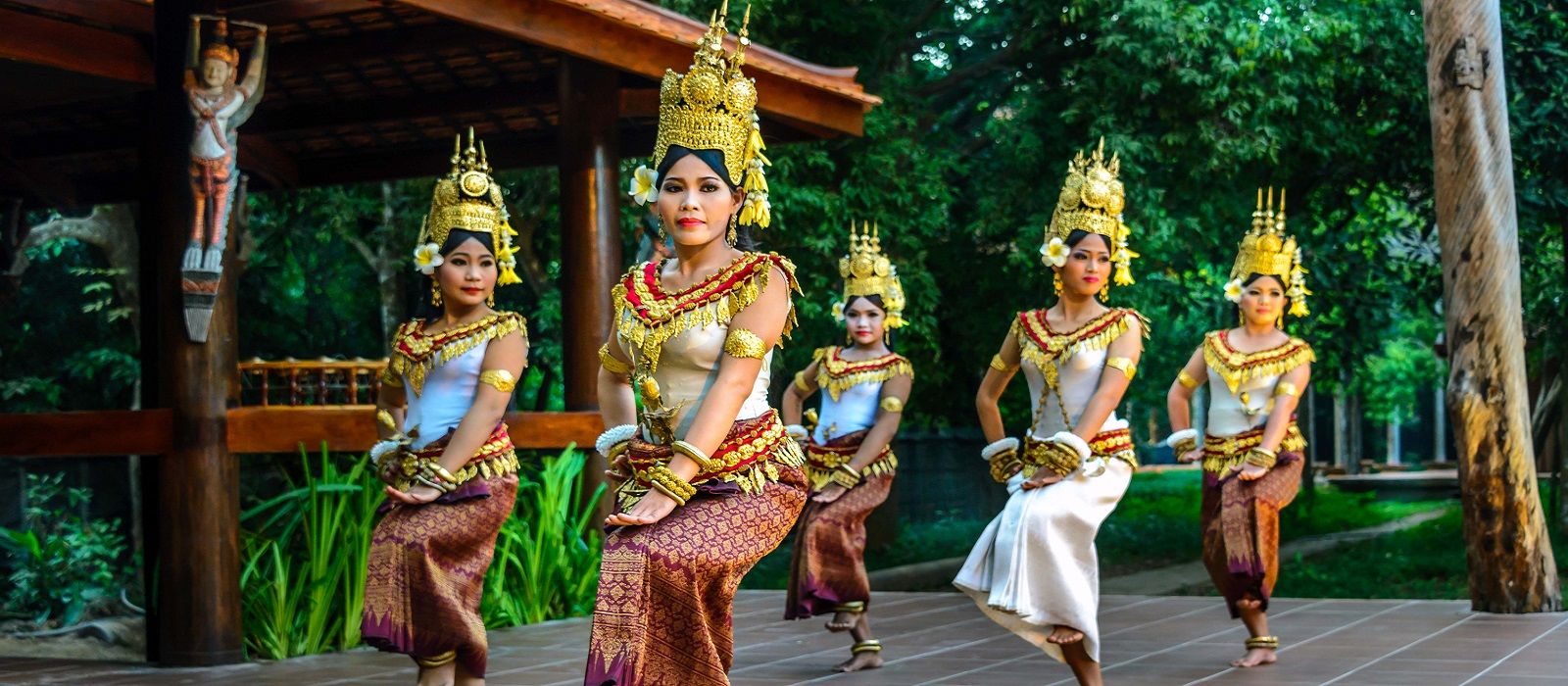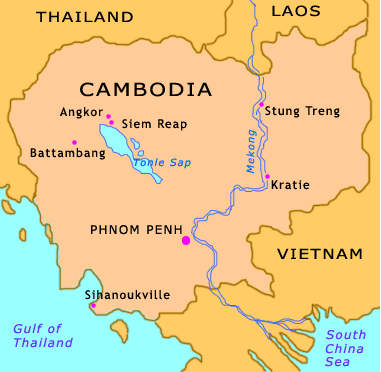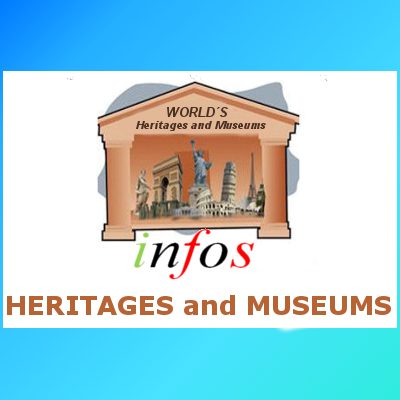Map of Cambodia
Cambodia has a population of over 16,25 million (2019). The official religion is Theravada Buddhism, practiced by approximately 95 percent of the population. The country's minority groups include Vietnamese, Chinese, Chams, and 30 hill tribes. The capital and largest city is Phnom Penh, the political, economic, and cultural centre of Cambodia. The kingdom is a constitutional monarchy with Norodom Sihamoni, a monarch chosen by the Royal Throne Council, as head of state. The head of government is Hun Sen, who is currently the longest serving non-royal leader in South East Asia and has ruled Cambodia for over 25 years.
In 802 AD, Jayavarman II declared himself king, uniting the warring Khmer princes of Chenla under the name "Kambuja". This marked the beginning of the Khmer Empire which flourished for over 600 years, allowing successive kings to control and exert influence over much of Southeast Asia and accumulate immense power and wealth. The Indianized kingdom built monumental temples including Angkor Wat, now a World Heritage Site, and facilitated the spread of first Hinduism, then Buddhism to much of Southeast Asia. After the fall of Angkor to Ayutthaya in the 15th century, a reduced and weakened Cambodia was then ruled as a vassal state by its neighbours. In 1863 Cambodia became a protectorate of France which doubled the size of the country by reclaiming the north and west from Thailand.
Cambodia gained independence in 1953. The Vietnam War extended into the country with the US bombing of Cambodia from 1969 until 1973. Following the Cambodian coup of 1970, the deposed king gave his support to his former enemies, the Khmer Rouge. The Khmer Rouge emerged as a major power, taking Phnom Penh in 1975 and later carrying out the Cambodian Genocide from 1975 until 1979, when they were ousted by Vietnam and the Vietnamese-backed People's Republic of Kampuchea in the Cambodian–Vietnamese War (1979–91). Following the 1991 Paris Peace Accords, Cambodia was governed briefly by a United Nations mission (1992–93). The UN withdrew after holding elections in which around 90 percent of the registered voters cast ballots. The 1997 coup placed power solely in the hands of Prime Minister Hun Sen and the Cambodian People's Party, who remain in power as of 2017.
The country faces numerous challenges. Important sociopolitical issues includes widespread poverty, pervasive corruption, lack of political freedoms, low human development, and a high rate of hunger. Cambodia has been described by Human Rights Watch's Southeast Asian Director, David Roberts, as a "vaguely communist free-market state with a relatively authoritarian coalition ruling over a superficial democracy."While per capita income remains low compared to most neighbouring countries, Cambodia has one of the fastest growing economies in Asia with growth averaging 6 percent over the last decade. Agriculture remains the dominant economic sector, with strong growth in textiles, construction, garments, and tourism leading to increased foreign investment and international trade Cambodia scored dismally in an annual index (2015) ranking the rule of law in 102 countries, placing 99th overall and the worst in the region.
Cambodia also faces environmental destruction as an imminent problem. The most severe activity in this regard is considered to be the countrywide deforestation, which also involves national parks and wildlife sanctuaries. Overall, environmental destruction in Cambodia comprise many different activities, including illegal logging, poaching of endangered and endemic species, and destruction of important wildlife habitats from large scale construction projects and agricultural businesses. The degrading activities involve the local population, Cambodian businesses and political authorities, as well as foreign criminal syndicates and many transnational corporations from all over the world.
Population
During 2017 Cambodia population is projected to increased by 259 010 people and reach 16 217 703 in the beginning of 2018. The natural increase is expected to be positive, as the number of births will exceed the number of deaths by 290 927. If external migration will remain on the previous year level, the population will be declined by 31 917 due to the migration reasons. It means that the number of people who leave Cambodia to settle permanently in another country (emigrants) will prevail over the number of people who move into the country (to which they are not native) in order to settle there as permanent residents (immigrants).
Languages
The Khmer language is a member of the Mon–Khmer subfamily of the Austroasiatic language group. French, once the language of government in Indochina, is still spoken by many older Cambodians, and is also the language of instruction in some schools and universities that are funded by the government of France. There is also a French-language newspaper and some TV channels are available in French. Cambodia is a member of La Francophonie. Cambodian French, a remnant of the country's colonial past, is a dialect found in Cambodia and is sometimes used in government, particularly in court. However, since 1993, there has been a growing use of English, that has been replacing French as the main foreign language. English is widely taught in several universities and there is also a significant press in that language, while street signs are now bilingual in Khmer and English. Due to this shift, English is now mostly used in Cambodia's international relationships and has replaced French both in Cambodia's stamps, since 2002, and currency.
Currency
The Cambodian Riel is the currency of Cambodia. Our currency rankings show that the most popular Cambodia Riel exchange rate is the KHR to USD rate. The currency code for Riels is KHR, and the currency symbol is ៛.

Geography
Cambodia has an area of 181,035 square kilometres (69,898 square miles) and lies entirely within the tropics, between latitudes 10° and 15°N, and longitudes 102° and 108°E. It borders Thailand to the north and west, Laos to the northeast, and Vietnam to the east and southeast. It has a 443-kilometre (275-mile) coastline along the Gulf of Thailand.
Cambodia's landscape is characterised by a low-lying central plain that is surrounded by uplands and low mountains and includes the Tonle Sap (Great Lake) and the upper reaches of the Mekong River delta. Extending outward from this central region are transitional plains, thinly forested and rising to elevations of about 650 feet (200 metres) above sea level.
To the north the Cambodian plain abuts a sandstone escarpment, which forms a southward-facing cliff stretching more than 200 miles (320 kilometres) from west to east and rising abruptly above the plain to heights of 600 to 1,800 feet (180–550 metres). This cliff marks the southern limit of the Dângrêk Mountains.
Flowing south through the country's eastern regions is the Mekong River. East of the Mekong the transitional plains gradually merge with the eastern highlands, a region of forested mountains and high plateaus that extend into Laos and Vietnam. In southwestern Cambodia two distinct upland blocks, the Krâvanh Mountains and the Dâmrei Mountains, form another highland region that covers much of the land area between the Tonle Sap and the Gulf of Thailand.
In this remote and largely uninhabited area, Phnom Aural, Cambodia's highest peak rises to an elevation of 5,949 feet (1,813 metres). The southern coastal region adjoining the Gulf of Thailand is a narrow lowland strip, heavily wooded and sparsely populated, which is isolated from the central plain by the southwestern highlands.
The most distinctive geographical feature is the inundations of the Tonle Sap (Great Lake), measuring about 2,590 square kilometres (1,000 square miles) during the dry season and expanding to about 24,605 square kilometres (9,500 square miles) during the rainy season. This densely populated plain, which is devoted to wet rice cultivation, is the heartland of Cambodia. Much of this area has been designated as a biosphere reserve.
Climate

Cambodia's climate, like that of the rest of Southeast Asia, is dominated by monsoons, which are known as tropical wet and dry because of the distinctly marked seasonal differences.
Cambodia has a temperature range from 21 to 35 °C (69.8 to 95.0 °F) and experiences tropical monsoons. Southwest monsoons blow inland bringing moisture-laden winds from the Gulf of Thailand and Indian Ocean from May to October. The northeast monsoon ushers in the dry season, which lasts from November to April. The country experiences the heaviest precipitation from September to October with the driest period occurring from January to February.
Cambodia has two distinct seasons. The rainy season, which runs from May to October, can see temperatures drop to 22 °C (71.6 °F) and is generally accompanied with high humidity. The dry season lasts from November to April when temperatures can rise up to 40 °C (104 °F) around April. Disastrous flooding occurred in 2001 and again in 2002, with some degree of flooding almost every year.
Religion
Theravada Buddhism is the official religion of Cambodia, practised by more than 95 percent of the population with an estimated 4,392 monastery temples throughout the country. Cambodian Buddhism is deeply pervaded by Hinduism, Tantrism, and native animism. Key concepts in Cambodian Buddhism include reincarnation, and religious activities are focused on acquiring bonn (Pali punna, merit), and erasing kamm (Pali kamma, karma), which, for Khmers, means the negative results accrued from past actions.

Key concepts deriving from animism include the close interrelationship between spirits and the community, the efficacy of apotropaic and luck-attracting actions and charms, and the possibility of manipulating one's life through contact with spiritual entities such as the "baromey" spirits. Hinduism has left little trace beyond the magical practices of Tantricism and a host of Hindu gods now assimilated into the spirit world (for example, the important neak ta spirit called Yeay Mao is the modern avatar of the Hindu goddess Kali).
Mahayana Buddhism is the religion of the majority of Chinese and Vietnamese in Cambodia. Elements of other religious practices, such as the veneration of folk heroes and ancestors, Confucianism, and Taoism mix with Chinese Buddhism are also practised.
Islam is followed by about 2% of the population and comes in three varieties, two practised by the Cham people and a third by the descendants of Malays resident in the country for generations. Cambodia's Muslim population is reported to be 80% ethnic Cham.
Economy
Economic developments in Cambodia so far in 2016 have unfolded broadly as expected. Exports from the important garment and footwear industry rose by 9.4% in the first half, almost double the pace in the same period of 2015. Tourist arrivals rose by 3.4% in January-July, marking deceleration from growth at 4.9% a year earlier. Better weather since June following an extended drought suggests modest recovery in agriculture this year.
The economy continued to grow at a robust pace last year, benefiting from solid domestic demand, which was in turn supported by strong credit growth, and expanding exports, especially from the textile sector. Moreover, a booming housing market and the growing tourist sector propelled construction activity. Nevertheless, political tensions continue. In late January Cambodia’s Parliament, controlled by Prime Minister Hun Sen’s ruling Cambodian People’s Party, voted to deprive the main opposition leader of the minority leader status, a key role which had given him some political powers. Analysts have interpreted the decision as a move to facilitate the victory of the ruling party in the next national elections, scheduled for July 2018.
Health
Cambodian life expectancy was 72 years in 2014, a major improvement since 1999 when the average life expectancy was 49.8 and 46.8. Health care is offered by both public and private practitioners and research has found that trust in health providers is a key factor in improving the uptake of health care services in rural Cambodia. The government plans to increase the quality of healthcare in the country by raising awareness of HIV/AIDS, malaria, and other diseases.
Cambodia's infant mortality rate has decreased from 115 per 1,000 live births in 1993 to 54 in 2009. In the same period, the under-five mortality rate decreased from 181 to 115 per 1,000 live births. In the province with worst health indicators, Ratanakiri, 22.9% of children die before age five.
Cambodia was once one of the most landmined countries in the world. According to some estimates, unexploded land mines have been responsible for over 60,000 civilian deaths and thousands more maimed or injured since 1970. The number of reported landmine casualties has sharply decreased, from 800 in 2005 to 111 in 2013 (22 dead and 89 injured). Adults that survive landmines often require amputation of one or more limbs and have to resort to begging for survival. Cambodia is expected to be free of land mines by 2020 but the social and economic legacy, including orphans and one in 290 people being an amputee, is expected to affect Cambodia for years to come.
"In Cambodia, landmines and exploded ordnance alone have caused 44,630 injuries between 1979 and 2013, according to the Cambodia Mine/UXO Victim Information System"
Tourism
The tourism industry is the country's second-greatest source of hard currency after the textile industry. Between January and December 2007, visitor arrivals were 2.0 million, an increase of 18.5% over the same period in 2006. Most visitors (51%) arrived through Siem Reap with the remainder (49%) through Phnom Penh and other destinations.
Other tourist destinations include Sihanoukville in the south west which has several popular beaches and the sleepy riverside town of Battambang in the north west, both of which are a popular stop for backpackers who make up a large of portion of visitors to Cambodia. The area around Kampot and Kep including the Bokor Hill Station are also of interest to visitors. Tourism has increased steadily each year in the relatively stable period since the 1993 UNTAC elections; in 1993 there were 118,183 international tourists, and in 2009 there were 2,161,577 international tourists.
Most of the tourists were Japanese, Chinese, Filipinos, Americans, South Koreans and French, said the report, adding that the industry earned some 1.4 billion US dollars in 2007, accounting for almost ten percent of the kingdom's gross national product. Chinese-language newspaper Jianhua Daily quoted industry officials as saying that Cambodia will have three million foreign tourist arrivals in 2010 and five million in 2015. Tourism has been one of Cambodia's triple pillar industries. The Angkor Wat historical park in Siem Reap province, the beaches in Sihanoukville and the capital city Phnom Penh are the main attractions for foreign tourists.
Cambodia's tourist souvenir industry employs a lot of people around the main places of interest. Obviously, the quantity of souvenirs that are produced is not sufficient to face the increasing number of tourists and a majority of products sold to the tourists on the markets are imported from China, Thailand and Vietnam. Some of the locally produced souvenirs include:
- Krama (traditional scarf)
- Ceramic works
- Soap, candle, spices
- Wood carving, lacquerware, silverplating
- Painted bottles containing infused rice wine
Culture

Various factors contribute to the Cambodian culture including Theravada Buddhism, Hinduism, French colonialism, Angkorian culture, and modern globalisation. The Cambodian Ministry of Culture and Fine Arts is responsible for promoting and developing Cambodian culture. Cambodian culture not only includes the culture of the lowland ethnic majority, but also some 20 culturally distinct hill tribes colloquially known as the Khmer Loeu, a term coined by Norodom Sihanouk to encourage unity between the highlanders and lowlanders.
Rural Cambodians wear a krama scarf which is a unique aspect of Cambodian clothing. The sampeah is a traditional Cambodian greeting or a way of showing respect to others. Khmer culture, as developed and spread by the Khmer empire, has distinctive styles of dance, architecture and sculpture, which have been exchanged with neighbouring Laos and Thailand throughout history. Angkor Wat (Angkor means "city" and Wat "temple") is the best preserved example of Khmer architecture from the Angkorian era along with hundreds of other temples that have been discovered in and around the region.
Traditionally, the Khmer people have a recorded information on Tra leaves. Tra leaf books record legends of the Khmer people, the Ramayana, the origin of Buddhism and other prayer books. They are taken care of by wrapping in cloth to protect from moisture and the climate.
Bon Om Tuuk (Festival of Boat Racing), the annual boat rowing contest, is the most attended Cambodian national festival. Held at the end of the rainy season when the Mekong river begins to sink back to its normal levels allowing the Tonle Sap River to reverse flow, approximately 10% of Cambodia's population attends this event each year to play games, give thanks to the moon, watch fireworks, dine, and attend the boat race in a carnival-type atmosphere.
Popular games include cockfighting, soccer, and kicking a sey, which is similar to a footbag. Based on the classical Indian solar calendar and Theravada Buddhism, the Cambodian New Year is a major holiday that takes place in April. Recent artistic figures include singers Sinn Sisamouth and Ros Serey Sothea (and later Meng Keo Pichenda), who introduced new musical styles to the country.
Sports
Football (soccer) is one of the most popular sports, although professional organised sports are not as prevalent in Cambodia as in western countries because of the economic conditions. Soccer was brought to Cambodia by the French and became popular with the locals. The Cambodia national football team managed fourth in the 1972 Asian Cup, but development has slowed since the civil war.
Western sports such as basketball, volleyball, bodybuilding, field hockey, rugby union, golf, and baseball are gaining popularity. Volleyball is by far the most popular sport in the country. Native sports include traditional boat racing, buffalo racing, Pradal Serey, Khmer traditional wrestling and Bokator. Cambodia first participated in the Olympics during the 1956 Summer Olympic Games sending equestrian riders. Cambodia also hosted the GANEFO Games, the alternative to the Olympics, in the 1960s.
Transport
The civil war and neglect severely damaged Cambodia's transport system. With assistance from other countries Cambodia has been upgrading the main highways to international standards and most are vastly improved from 2006. Most main roads are now paved.
Cambodia has two rail lines, totalling about 612 kilometres (380 miles) of single, one-metre (3-foot-3-inch) gauge track. The lines run from the capital to Sihanoukville on the southern coast. Trains are again running to and from the Cambodian capital and popular destinations in the south. After 14 years, regular rail services between the two cities restarted in May – offering a safer option than road for travelers aiming for some beach time. Trains also run from Phnom Penh to Sisophon (although trains often run only as far as Battambang). As of 1987, only one passenger train per week operated between Phnom Penh and Battambang but a $141 million project, funded mostly by the Asian Development Bank, has been started to revitalise the languishing rail system that will "(interlink) Cambodia with major industrial and logistics centers in Bangkok and Ho Chi Minh City".
Besides the main interprovincial traffic artery connecting Phnom Penh with Sihanoukville, resurfacing a former dirt road with concrete / asphalt and implementation of 5 major river crossings by means of bridges have now permanently connected Phnom Penh with Koh Kong, and hence there is now uninterrupted road access to neighbouring Thailand and their vast road system.
Cambodia's road traffic accident rate is high by world standards. In 2004, the number of road fatalities per 10,000 vehicles was ten times higher in Cambodia than in the developed world, and the number of road deaths had doubled in the preceding three years.
Cambodia's extensive inland waterways were important historically in international trade. The Mekong and the Tonle Sap River, their numerous tributaries, and the Tonle Sap provided avenues of considerable length, including 3,700 kilometres (2,300 miles) navigable all year by craft drawing 0.6 metres (2.0 feet) and another 282 kilometres (175 miles) navigable to craft drawing 1.8 metres (5.9 feet).
Cambodia has two major ports, Phnom Penh and Sihanoukville, and five minor ones. Phnom Penh, located at the junction of the Bassac, the Mekong, and the Tonle Sap rivers, is the only river port capable of receiving 8,000-ton ships during the wet season and 5,000-ton ships during the dry season. With increasing economic activity has come an increase in automobile and motorcycle use, though bicycles still predominate. "Cyclo" (as hand-me-down French) or Cycle rickshaws are an additional option often used by visitors. These kind of rickshaws are unique to Cambodia in that the cyclist is situated behind the passenger(s) seat, as opposed to Cycle rickshaws in neighbouring countries where the cyclist is at the front and "pulls" the carriage.
Cambodia has three commercial airports. Phnom Penh International Airport (Pochentong) in Phnom Penh is the second largest in Cambodia. Siem Reap-Angkor International Airport is the largest and serves the most international flights in and out of Cambodia. The other airport is in Sihanoukville.














